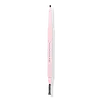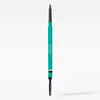What's inside
What's inside
 Key Ingredients
Key Ingredients

 Benefits
Benefits

 Concerns
Concerns

 Ingredients Side-by-side
Ingredients Side-by-side

Diisostearyl Malate
EmollientCaprylic/Capric Triglyceride
MaskingC20-40 Acid
CleansingMica
Cosmetic ColorantC20-40 Alcohols
EmulsifyingPolyethylene
AbrasiveSynthetic Wax
AbrasiveIsoamyl Laurate
EmollientGlyceryl Behenate/Eicosadioate
EmollientEthylcellulose
Boron Nitride
AbsorbentButyrospermum Parkii Butter
Skin ConditioningTocopherol
AntioxidantAscorbyl Palmitate
AntioxidantPropanediol
SolventPanax Ginseng Root Extract
EmollientIron Oxides
CI 77891
Cosmetic ColorantDiisostearyl Malate, Caprylic/Capric Triglyceride, C20-40 Acid, Mica, C20-40 Alcohols, Polyethylene, Synthetic Wax, Isoamyl Laurate, Glyceryl Behenate/Eicosadioate, Ethylcellulose, Boron Nitride, Butyrospermum Parkii Butter, Tocopherol, Ascorbyl Palmitate, Propanediol, Panax Ginseng Root Extract, Iron Oxides, CI 77891
Diisostearyl Malate
EmollientTriethylhexanoin
MaskingC20-40 Acid
CleansingC20-40 Alcohols
EmulsifyingPolyethylene
AbrasiveSynthetic Wax
AbrasiveGlyceryl Behenate/Eicosadioate
EmollientEthylene/Propylene Copolymer
AbrasiveEthylcellulose
Boron Nitride
AbsorbentVp/Eicosene Copolymer
Butyrospermum Parkii Butter
Skin ConditioningCeramide NP
Skin ConditioningSimmondsia Chinensis Seed Oil
EmollientTocopherol
AntioxidantEthylhexyl Palmitate
EmollientAscorbyl Palmitate
AntioxidantSilica Dimethyl Silylate
EmollientButylene Glycol
HumectantCaprylyl Glycol
EmollientHexylene Glycol
EmulsifyingSodium Hyaluronate
HumectantPhenoxyethanol
PreservativeIron Oxides
CI 77891
Cosmetic ColorantCI 77163
Cosmetic ColorantMica
Cosmetic ColorantDiisostearyl Malate, Triethylhexanoin, C20-40 Acid, C20-40 Alcohols, Polyethylene, Synthetic Wax, Glyceryl Behenate/Eicosadioate, Ethylene/Propylene Copolymer, Ethylcellulose, Boron Nitride, Vp/Eicosene Copolymer, Butyrospermum Parkii Butter, Ceramide NP, Simmondsia Chinensis Seed Oil, Tocopherol, Ethylhexyl Palmitate, Ascorbyl Palmitate, Silica Dimethyl Silylate, Butylene Glycol, Caprylyl Glycol, Hexylene Glycol, Sodium Hyaluronate, Phenoxyethanol, Iron Oxides, CI 77891, CI 77163, Mica
Ingredients Explained
These ingredients are found in both products.
Ingredients higher up in an ingredient list are typically present in a larger amount.
Ascorbyl Palmitate is created by combining pure Vitamin C and palmitic acid. It is an antioxidant and helps reduce hyperpigmentation.
This ingredient is a more stable version of Vitamin C, meaning it does not disintegrate as quickly when exposed to sunlight. However, studies show it does not penetrate skin as well as pure Vitamin C.
Ascorbyl Palmitate is oil soluble.
Read more about other types of Vitamin C:
Learn more about Ascorbyl PalmitateBoron Nitride is compound consisting of boron and nitrogen. It is used to absorb oil and modify adherence/ slip in products.
This means it is often used in makeup products to help them last longer.
This ingredient is also known as shea butter. It is an effective skin hydrator and emollient.
Emollients help soothe and soften your skin. It does this by creating a protective film on your skin. This barrier helps trap moisture and keeps your skin hydrated. Emollients may be effective at treating dry or itchy skin.
Shea butter is rich in antioxidants. Antioxidants help fight free-radicals, or molecules that may harm the body. It is also full of fatty acids including stearic acid and linoleic acid. These acids help replenish the skin and keep skin moisturized.
While Shea Butter has an SPF rating of about 3-4, it is not a sunscreen replacement.
Shea butter may not be fungal acne safe. We recommend speaking with a professional if you have any concerns.
Learn more about Butyrospermum Parkii ButterC20-40 Acid isn't fungal acne safe.
We don't have a description for C20-40 Alcohols yet.
Ci 77891 is a white pigment from Titanium dioxide. It is naturally found in minerals such as rutile and ilmenite.
It's main function is to add a white color to cosmetics. It can also be mixed with other colors to create different shades.
Ci 77891 is commonly found in sunscreens due to its ability to block UV rays.
Learn more about CI 77891Diisostearyl Malate is an emollient and most often used in lip products. It comes from isostearyl alcohol, a fatty acid, and malic acid, an AHA.
As an emollient, Diisostearyl Malate helps create a thin film on your skin to trap moisture in. This helps keep your skin soft and smooth.
We don't have a description for Ethylcellulose yet.
Glyceryl Behenate/Eicosadioate isn't fungal acne safe.
Mica is a naturally occurring mineral used to add shimmer and color in cosmetics. It can also help improve the texture of a product or give it an opaque, white/silver color.
Serecite is the name for very fine but ragged grains of mica.
This ingredient is often coated with metal oxides like titanium dioxide. Trace amounts of heavy metals may be found in mica, but these metals are not harmful in our personal products.
Mica has been used since prehistoric times throughout the world. Ancient Egyptian, Indian, Greek, Roman, Aztec, and Chinese civilizations have used mica.
Learn more about MicaPolyethylene is a synthetic ingredient that helps the skin retain moisture. It is a polymer.
It is also typically used within product formulations to help bind solid ingredients together and thicken oil-based ingredients. When added to balms and emulsions, it helps increase the melting point temperature.
Synthetic Wax is created from fossil fuels such as natural gas. It is used to enhance texture, adjust pH, and as an occlusive.
It may also be used as an abrasive ingredient to exfoliate the skin.
Synthetic Wax may not be fungal acne safe.
Learn more about Synthetic WaxTocopherol (also known as Vitamin E) is a common antioxidant used to help protect the skin from free-radicals and strengthen the skin barrier. It's also fat soluble - this means our skin is great at absorbing it.
Vitamin E also helps keep your natural skin lipids healthy. Your lipid skin barrier naturally consists of lipids, ceramides, and fatty acids. Vitamin E offers extra protection for your skin’s lipid barrier, keeping your skin healthy and nourished.
Another benefit is a bit of UV protection. Vitamin E helps reduce the damage caused by UVB rays. (It should not replace your sunscreen). Combining it with Vitamin C can decrease sunburned cells and hyperpigmentation after UV exposure.
You might have noticed Vitamin E + C often paired together. This is because it is great at stabilizing Vitamin C. Using the two together helps increase the effectiveness of both ingredients.
There are often claims that Vitamin E can reduce/prevent scarring, but these claims haven't been confirmed by scientific research.
Learn more about TocopherolThis ingredient is a combination of red, black, and yellow iron oxide pigments. This combination of colors is usually found in foundation, because it results in a "skin" color.